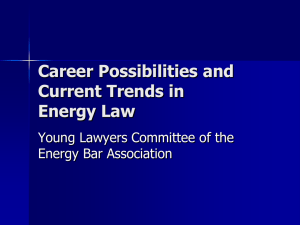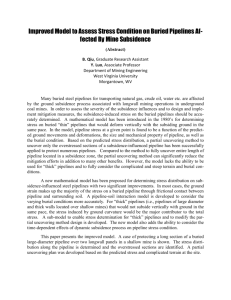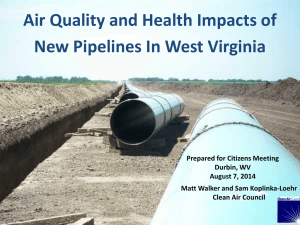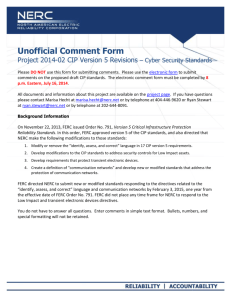FERC - jfortlaw.com
advertisement
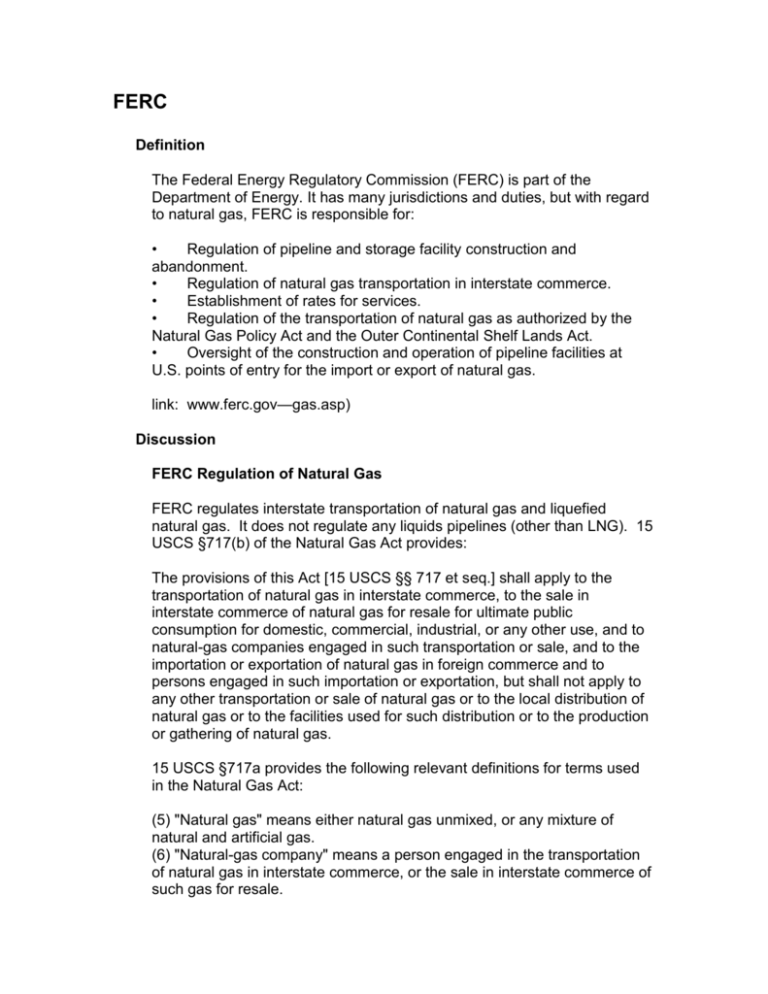
FERC Definition The Federal Energy Regulatory Commission (FERC) is part of the Department of Energy. It has many jurisdictions and duties, but with regard to natural gas, FERC is responsible for: • Regulation of pipeline and storage facility construction and abandonment. • Regulation of natural gas transportation in interstate commerce. • Establishment of rates for services. • Regulation of the transportation of natural gas as authorized by the Natural Gas Policy Act and the Outer Continental Shelf Lands Act. • Oversight of the construction and operation of pipeline facilities at U.S. points of entry for the import or export of natural gas. link: www.ferc.gov—gas.asp) Discussion FERC Regulation of Natural Gas FERC regulates interstate transportation of natural gas and liquefied natural gas. It does not regulate any liquids pipelines (other than LNG). 15 USCS §717(b) of the Natural Gas Act provides: The provisions of this Act [15 USCS §§ 717 et seq.] shall apply to the transportation of natural gas in interstate commerce, to the sale in interstate commerce of natural gas for resale for ultimate public consumption for domestic, commercial, industrial, or any other use, and to natural-gas companies engaged in such transportation or sale, and to the importation or exportation of natural gas in foreign commerce and to persons engaged in such importation or exportation, but shall not apply to any other transportation or sale of natural gas or to the local distribution of natural gas or to the facilities used for such distribution or to the production or gathering of natural gas. 15 USCS §717a provides the following relevant definitions for terms used in the Natural Gas Act: (5) "Natural gas" means either natural gas unmixed, or any mixture of natural and artificial gas. (6) "Natural-gas company" means a person engaged in the transportation of natural gas in interstate commerce, or the sale in interstate commerce of such gas for resale. In the natural gas industry, well in advance of any construction, the FERC authorizes both initial rates and tariff provisions. In contrast, traditionally oil pipelines have simply filed tariffs after construction. In practice, this seemingly risky approach was effective for many decades. Pipelines would execute “T&D” agreements—throughput and deficiency agreements binding prospective shippers to use pipeline capacity or pay for any deficiencies. Independent pipelines increase in number and importance, and integrated pipelines rely on both affiliated and non-affiliated shippers to support new capacity projects. In this environment, advance approval for significant pricing and service terms of pipeline tariffs has become increasingly important to obtain financial backing. Almost all applications to FERC for interstate natural gas pipeline projects require some level of coordination with one or more other Federal agencies. For example, the Environmental Protection Agency assists FERC and/or State authorities in determining if the environmental aspects of a pipeline development project meet acceptable guidelines. FERC is also required to take the lead on the environmental reviews under the National Environmental Policy Act, the Endangered Species Act, the National Historic Preservation Act, and the Magnuson-Stevens Act. Governing the safety standards, procedures, and actual development and expansion of any pipeline system is the job of the U.S. Department of Transportation’s Office of Pipeline Safety (OPS). A pipeline may not begin operations until a line, or line segment, has been certified safe by the OPS. The OPS retains jurisdiction for safety over the lifetime of the pipeline. See: www.eia.gov—regulatory.html FERC and Oil Pipelines Understanding FERC’s history is helpful as is contrasting its regulation of oil pipelines. See: "Growing Pains: FERC's Responses to Challenges to the Development of Oil Pipeline Infrastructure," Christopher J. Barr, 28 Energy Law Journal 43 (2007). Federal regulation of interstate oil pipelines was initiated under the Hepburn Act of 1906 (Act). This Act brought oil pipelines under the Interstate Commerce Act of 1887 (ICA), which originally applied only to railroads. The Act made interstate oil pipelines common carriers subject to rate regulation by the Interstate Commerce Commission. The ICA applies to the transportation of oil and oil products from one state to any other state and from a foreign country to any place in the United States. The ICA leaves unregulated the construction and abandonment of oil pipelines, sales and leases, securities transactions, and provision of nontransportation services. The responsibility for regulating oil pipeline rates was vested in the ICC until 1977, when the Department of Energy Organization Act was enacted. That Act transferred jurisdiction over oil pipeline regulation from the ICC to the new Department of Energy and the Federal Power Commission, the predecessor of the Federal Energy Regulatory Commission (FERC). 49 U.S.C. Sections 7155, 7172(b). The FERC now regulates oil pipelines rates and tariffs. Under the Code of Federal Regulations Title 18, FERC's jurisdiction over oil pipelines is limited primarily to interstate pipeline rates. Under Title 18, common carrier pipelines are required to file an annual report with FERC. Terminology for the industry is quite varied. “Oil pipelines,” or “liquids pipelines,” is a broader term often used in the oil business, but generally includes pipelines that transport crude oil, bitumen, and synthetic crude processed from tar sands and petroleum products, which encompasses a broad range of substances. However, the terminology most frequently used in federal regulatory settings and by the public at large is “oil pipelines" or “petroleum pipelines.” These pipelines are regulated under the Interstate Commerce Act by the FERC. The FERC’s regulation of oil pipelines is more limited than that of gas or electric companies and does not include any jurisdiction over exit or entry from the business. The FERC does regulate the reasonableness of rates and services and thus has potentially decisive authority regarding the commercial viability of new oil pipeline proposals. The FERC has overcome the absence of certificate authority to provide advance rate and tariff approvals by issuing declaratory orders prior to construction. With respect to oil, the FERC website says: The Commission's responsibilities include: • Regulation of rates and practices of oil pipeline companies engaged in interstate transportation; • Establishment of equal service conditions to provide shippers with equal access to pipeline transportation; and • Establishment of reasonable rates for transporting petroleum and petroleum products by pipeline. 49 USCS §60502 and 18 CFR Part 341 confirms the authority of FERC over oil pipeline access and tariffs but neither portion of the statute or code defines "oil" or "oil pipeline." State utility commission regulation of intrastate transportation. To the extent that oil pipelines transport petroleum in intrastate commerce, [Interstate petroleum products must originate in one state and cross state boundaries before transportation comes to an end—often at a refinery (for crude oil) or at a terminal (for products). The test of whether the transportation has come to an end is the “fixed and original intent of the shipper”—a standard that can be fact-specific. Sinclair Oil Corp. v. Chevron Texaco Pipeline Co., 105 F.E.R.C. ¶ 61,290 (2003).] State commissions may regulate their rates and services and may indeed go further than the FERC’s reach to regulate changes to facilities, leases, and changes in ownership. [For example, Wyoming and Michigan exercise broad jurisdiction over oil pipelines, including asset transfers, while Connecticut does not regulate them at all, and Ohio regulates only crude petroleum pipelines.] These and similar environmental and permitting issues loom large but are outside FERC’s jurisdiction. The FERC does, however, exercise substantial authority on key oil pipeline issues. The FERC does not regulate oil pipeline entry, construction, commencement of new services, or abandonment. Farmers Union Central Exchange v. FERC, 584 F.2d 408 (D.C. Cir. 1978); Arco Alaska v. FERC, 89 F.3d 878 (D.C. Cir. 1996). The FERC does require publication of tariffs. It also regulates rates, determines whether the rules and regulations of service are just, reasonable, and non-discriminatory, and enforces the obligation to accept requests for transportation on “reasonable request.” Despite its relatively limited scope, the FERC’s authority reaches critical issues for new or expanding pipelines: the price for their service and the terms and conditions for the proposed transportation. Pipeline owners are free to build facilities or not, but once placed in service, the FERC has exclusive jurisdiction over the rates and tariffs. If those rates and terms of service fail to reflect the needs of investors, however, pipelines’ right to abandon service would usually remain quite theoretical, as the capitalintensive, immobile assets cannot readily be redeployed. Consequently, the manner in which the FERC exercises its jurisdictional authority is of critical importance to the advancement of oil pipeline infrastructure.

